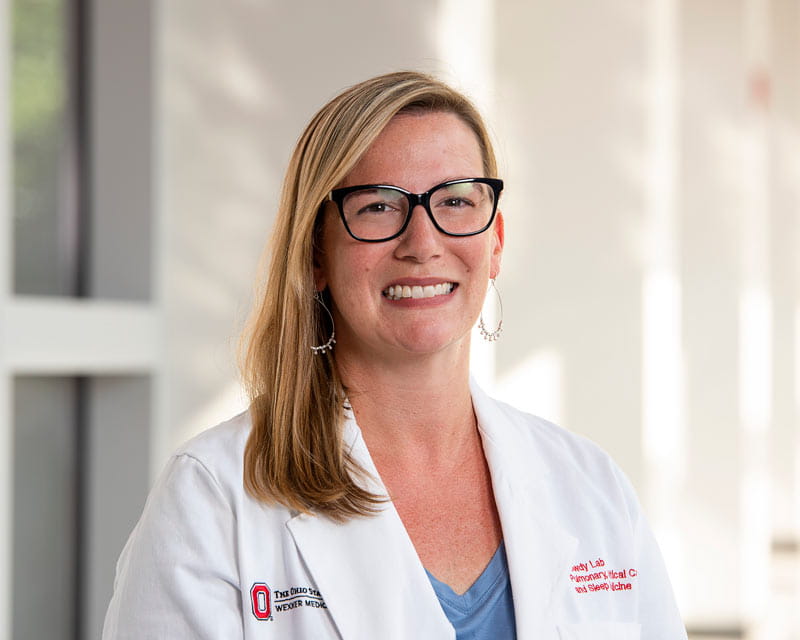
Ohio State Researchers Launch NIH-Funded Study on Ozone-Induced Pulmonary Inflammation
 In February 2021, The Ohio State University Wexner Medical Center welcomed Ana Mora, MD, associate director of lung research at the Dorothy M. Davis Heart and Lung Research Institute, and Mauricio Rojas, MD, associate vice chair for research in the Department of Internal Medicine, into the Division of Pulmonary, Critical Care and Sleep Medicine. The duo, who have worked together for more than 25 years, have devoted their research to better understanding how the lungs recover from injury and how aging plays a role in pathogenic processes that inhibit healing.
In February 2021, The Ohio State University Wexner Medical Center welcomed Ana Mora, MD, associate director of lung research at the Dorothy M. Davis Heart and Lung Research Institute, and Mauricio Rojas, MD, associate vice chair for research in the Department of Internal Medicine, into the Division of Pulmonary, Critical Care and Sleep Medicine. The duo, who have worked together for more than 25 years, have devoted their research to better understanding how the lungs recover from injury and how aging plays a role in pathogenic processes that inhibit healing.
Almost 20 years ago, Rojas began investigating the possibility of using stem cells as a therapeutic option for patients with acute lung injury.
He says, “At that time, we understood that stem cells were one of the main mechanisms by which the lungs and other organs recovered after injury. After at least 15 years of bench studies demonstrating stem cell effectiveness in preclinical animal models, we recently published work on multicenter clinical trials in the U.S. and U.K. that demonstrated, for the first time, that stem cells can be used to treat patients hospitalized in the intensive care unit with acute lung injury.
“From the stem cell-based therapies point of view, our research is almost complete. Currently, there is an ongoing phase III clinical trial specifically designed to define the level of protection conferred by stem cells, and that will be the final step before the first cell therapy can be approved for clinical use,” Rojas says.
The team was also intrigued by the fact that, with age, the ability of the lung to recover after injury was dramatically diminished. In a simple experiment, Rojas’s laboratory induced lung injury in young and aging mice. They found that aging mice were more susceptible to injury and, like elderly individuals, aging mice experienced a progressive, not resolving, disease process.
After a series of experiments, the team was able to define that stem cells, like any other cells, are affected by aging. Aging cells accumulate defects in their DNA, mitochondria and other organelles, ultimately leading to a lower capacity to respond to stress. Accumulation of these defects also drives the cells into a phase called senescence where the cells stop dividing. They don’t die, but they actively express factors that promote inflammation and other proteins, like collagen, which impact the niche environment, Rojas explains.
For the last 10 years, building off that work, Mora and Rojas’ research has been focused on understanding how aging increases susceptibility to developing chronic lung diseases.
“It is well recognized that with age there is an increase in the prevalence and incidence of several chronic diseases such as diabetes, cardiovascular and neurodegenerative diseases, and cancer. But we realized that age is also the most significant risk factor for the development of chronic lung diseases, such as idiopathic pulmonary fibrosis (IPF), chronic obstructive pulmonary disease (COPD) and lung cancer. We’re now trying to understand why,” Rojas notes.
The team began looking for mechanisms responsible for cellular aging and age-related diseases. In tissue samples from aging donors and aging lung diseases, they found multiple defects, including dysfunctional mitochondria and exhaustion of stem cells, among other defects associated with cellular aging.
Rojas also notes, “We found a significant increase in senescent cells. These cells have a negative impact on the lungs’ ability to repair, and they accumulate and promote the development of chronic diseases.”
A significant portion of Mora’s research is also focused on mitochondria and how those organelles don't work properly as the cell ages. Normally, as mitochondria accumulate damage over time, they're destroyed by a mechanism called mitophagy.
“We have evidence that, with age and diseases like IPF, damaged mitochondria accumulate instead of being destroyed,” Mora says. “When this happens, we start to see the activation of responses that promote fibrosis.”
Mitochondrial dysfunction also promotes senescence. Senescence is another major focus of the research. Her team has been using animal models to study these cells, together with samples taken from human tissues. They seek to understand how these cells accumulate in the lung during the lifespan, define their phenotype and recognize them in order to design approaches to specifically destroy senescent cells.
Senescence can be triggered by factors other than mitochondrial dysfunction. Short telomeres, oxidative damage and proteostatic stress can also lead to senescence.
“It is recognized that the phenotype of senescence cells and the set of secretory factors that they produce might differ with the cell type and the stimulus that triggers senescence. Characterization of the heterogeneous senescence cell phenotype is critical to define methods to recognize them and develop inhibitors of the senescence-associated secretory phenotype or new senolytic drugs to kill senescence cells,” Mora explains.
A potential key aspect is that cells that undergo senescence reprogram their metabolism.
“We are also studying if senescence cells utilize different metabolic pathways than normal cells. Our preliminary studies show there are differences in key pathways mainly associated with lipid metabolism. We also have found that cells with certain metabolic defects are more prone to senescence. We are defining if we can prevent or modify senescence by manipulating their cell metabolism. Our final goal is to find new therapeutic methods that we can apply to promote healthy aging and also to reverse existing age-related lung diseases,” she says.
To help move the aging research field forward at the Ohio State Wexner Medical Center, Mora and Rojas, and their teams, formed the aging interest group in close collaboration with other faculty, PhDs and physician scientists on campus.
“Aging is the common risk factor for many diseases that limit life and health spans. Several basic mechanisms have been identified as the hallmarks of aging that are present in aging cells and participate in the pathogenesis of age-related diseases. This is a common ground to collaborate and work together. It is possible that similar interventions might benefit diverse diseases associated with aging,” Rojas says.
“We’re trying to fit this all together. In our discussions, the group learns about aging in various organs, learns the pathobiology of distinct aging disease and sees if they can apply those same principles to their research interests.”
Mora and Rojas’ laboratories are working together in the identification and mapping of senescence cells in the human lung and heart to define their phenotype and identify potential novel therapeutic targets. The National Institutes of Health (NIH) awarded the team a U54 grant to form a Tissue Mapping Center, which will be part of the NIH Common Fund’s Cellular Senescence Network.
Together with colleagues from the University of Pittsburgh, the University of Rochester and Carnegie Mellon University, they’ll attempt to map those cells, seeking to answer questions like: Where are they located? What genes do they express? What is their phenotype? Not all senescent cells are the same, and if researchers can better understand their markers and the cellular signals they produce, they may be able to target them with new therapies.
Learn more about innovations in care and research from the Division of Pulmonary, Critical Care and Sleep Medicine.